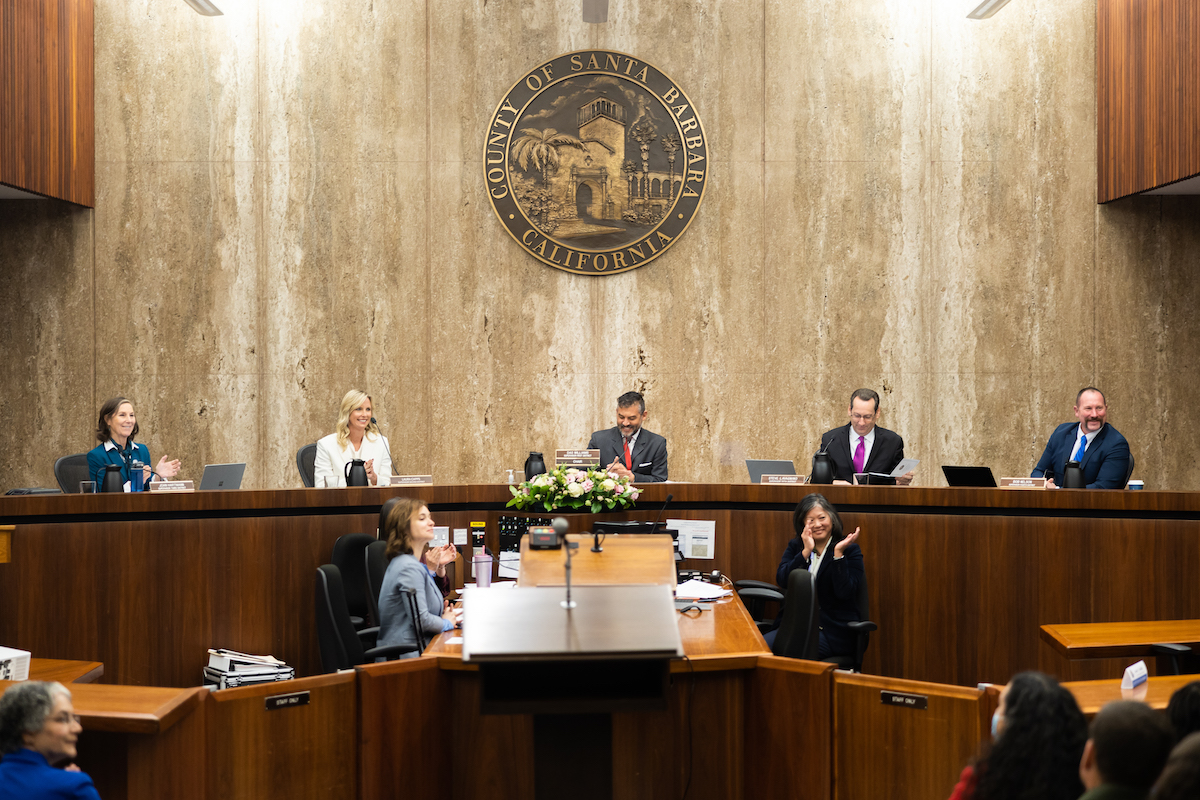Santa Barbara County farmworkers spoke out about working long days in extreme heat and sustaining injuries from heavy rains to the Board of Supervisors on Tuesday morning. They were advocating for a living wage amid the blistering effects of climate change.
Later in the meeting, supervisors referred to these stories in discussing the county’s ambitious 2030 Climate Action Plan (CAP). The plan outlines ways to reduce greenhouse-gas emissions by 2030 and, under the California Environmental Quality Act, to provide the county with the ability to streamline the environmental review process of future development projects.
Despite containing a few wrinkles, the board voted 3-2 to adopt the plan and iron it out later.
It took four years to get the final plan before the board, including “aspirational measures and goals” and “actions that could be implemented” to reduce emissions by 50 percent below 2018 levels. Adoption, it was noted, would not automatically enact any policy, program, or project. Still, the plan’s bare bones were nitpicked from all sides.
An oil-and-gas-shaped elephant loomed over the boardroom, which, notably, is in Santa Maria, the county’s oil country. Any regulations on the oil and gas industry were absent from the CAP, leading to much pushback from environmental groups.
Although Sable Offshore — the oil company attempting to restart offshore oil drilling operations, including the pipeline that caused the devastating 2015 Refugio Oil Spill — was not mentioned by name during the meeting, its presence was felt.
Environmental groups contended that the CAP would be insufficient if oil and gas operations, such as Sable’s, were omitted. What is included, however, are multiple, broad goals, from increasing the use of zero-emission vehicles, to reducing food waste and water consumption, to supporting sustainable land management and a low-carbon, clean-energy economy.
Many of these groups at the meeting said they still wanted to see the plan pass, and emphasized that the county is already experiencing extreme climate-related events, from storms to wildfire, on a regular basis. July, one commenter mentioned, was California’s hottest month on record.
Supervisor Joan Hartmann agreed. “We’re talking about business as usual, and we’re not in that; we’re in a serious crisis for human life as we know it,” she said. “To take it as just another issue seems to be missing the whole point.”
Other public commenters worried about the individual costs to residents and businesses, on top of the $337,622,000 in up-front costs the county is facing to implement the plan over the next five years.
However, for now, the current plan, and the proposed “oil and gas resolution” that was stuck to the top, are merely words on paper.
Rather than update the current plan, the board will direct staff to identify viable measures to reduce emissions from oil and gas processing and return to the board in six months for consideration.
Staff stressed that the county has already adopted a threshold of 1,000 metric tons of CO2 emissions for stationary sources, including oil and gas, and the county has not since received any new applications for oil or gas extraction.
Ben Oakley, with the Western States Petroleum Association, reminded the board that oil and gas operations are already regulated by more than two dozen agencies, including the California Air Resources Board, saying that any policies to curtail oil and gas activities would be “arbitrary” and result in millions in legal fees to defend their decision, pointing to Ventura as a “cautionary tale.”
Still, Supervisors Laura Capps, Joan Hartmann, and Das Williams voted in favor of adopting the plan with the proposed oil and gas resolution. Hartmann and Capps acknowledged the massive task of implementation, and the effort it will take to translate words into action, but emphasized the importance of having the CAP “framework” as a jumping-off point to then develop more concrete steps.
“I’m hoping to pass this and immediately start on implementation with stakeholders like school districts, Cottage Hospital, and major employers,” Capps said. “This is a very audacious goal — 50 percent of emissions by 2030, when we’re talking now in August 2024.”
Williams said the plan should be treated with urgency, particularly in the categories that are easier to implement. He said that “this document is focused on the largest areas where we can make reductions in the most cost-effective manner.” He emphasized that “contrary to popular belief, this is not just Das sitting in a room somewhere coming up with all these things — this is an enormous effort with a ton of stakeholders.”
Williams said that it is “more than a plan”; it is a “community-driven vision for a more equitable and resilient future, and therefore is fundamentally ambitious and transformative,” which will rely on collaboration with regional agencies and individual communities.
The two North County supervisors, Bob Nelson and Steve Lavagnino, however, were not sold on this golden vision, citing disillusionment with the county’s past plans to reduce emissions and the plan’s potential impacts on households and businesses.
Nelson said he thinks the county is “a leader” in reducing emissions, with other initiatives such as limiting greenhouse gases from passing marine vessels through the Blue Whales and Blue Skies program, and worried about the effects on housing affordability and the costs associated with, for example, the switch from gas-powered to electrical appliances outlined in the CAP.
Lavagnino somewhat disagreed, saying the county is a “leader in rhetoric.”
“We’re good at talking about it, not so good at doing it, because, I know people don’t want to hear this, but we don’t get it done,” he said. The County’s 2015 goal to reduce emissions to 15 percent below 2007 levels by 2020, he said, failed. Three years later, they “didn’t lose 30 pounds,” he said, “we had freaking gained 20 pounds.”
However, Hartmann said, “We need to take a major step to transform how we’re operating as a community, and this is a framework to start in that direction. We’re going down the path without knowing all the answers, but it’s good to start.”
To learn more about the 2030 Climate Action Plan, visit the county’s website.











